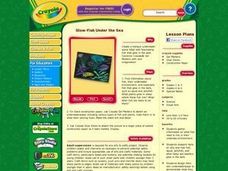Curated OER
The Five Classes of Vertebrates
What a terrific lesson! Learners discuss the animal kingdom, and classify them as vertebrates and invertebrates. They also identify them as fish, amphibians, reptiles, birds, and mammals. There is even a taxonomic breakdown of popular...
Curated OER
Types of Animals
Learning about animals, and their classifications, is a regular part of the elementary-school curriculum. Using this presentation, learners can review information relating to animal classification, and test their knowledge. This would be...
Curated OER
Ocean of Words
Learners explore aspects of the ocean. In this ocean wildlife instructional activity, students watch a power point presentation on the ocean. Learners complete a worksheet on what they learned.
Curated OER
Life-Like Replicas: Fish
Students research a fish or other underwater animal that interests them. They compare and contrast the images they gather with the different stages of production of their sculptural model to create a life-like replica. Students represent...
Curated OER
Glow-Fish Under The Sea
Students engage in a lesson that is concerned with the concept of ecosystems. They focus upon conducting research to find information about the water ecosystem. The facts are used as influence to create a drawing of an underwater...
Curated OER
Shark Vocabulary
In this sharks worksheet, students read 10 definitions that pertain to sharks. Students match these definitions to vocabulary words in a word box.
Curated OER
Aquatic Life
Sixth graders work in pairs to research information related to aquatic life using references from the World Wide Web. They present their findings in the form of an oral presentation to the class.
Curated OER
Something's Fishy. . . Classes and Qualities of Fish and Seafood
If you are going to eat seafood, it helps to understand the different classifications. In this presentation, viewers learn to differentiate two types of finfish and the variations of edible shellfish. They also examine the...
Curated OER
Fish Banners
An art lesson involving fish can accent a wide variety of subjects. Here are the steps needed to create a fish banner with paint, shapes, cardboard, and paper. This would be a nice way to start or finish a unit on fish or underwater...
Curated OER
Physical Changes Pre-Quiz
Quiz the class on what they know before you teach it. This assessment will give you an idea of what basic scientific concepts are known to your learners. Physical change, state of matter, and basic plant and animal needs are covered.
Curated OER
Go Fish
Here is a good art instructional activity on creating colorful versions of fish. After studying images of a variety of fish, young artists choose one that they want to create an image of. Using some high-quality materials, they create...
Curated OER
Explore Fish
Read Animals Called Fish with your young Spanish language learners and talk about the different parts of a fish. After teaching terms like huesos, columna vertebral, aletas, escamas, etc, Learners...
Curated OER
Vertebrates: Part I, Fishes & Amphibians
A simple set of slides shares the three classes of fish and the class amphibia. The first three slides cover fish characteristics and structure, while the last three cover amphibian characteristics and life cycle. Though somewhat...
Curated OER
Fish Anatomy
Add a handy reference sheet about fish anatomy and functioning to your learners' biology or animal notebooks. Though this resource doesn't provide any practice, it makes a useful addition to any study of anatomy, biology, species, fish,...
Curated OER
Animal Classification
Second graders identify characteristics of and group animals by the five categories of vertebrates.
Curated OER
King Bidgood's in the Bathtub
students add their own scenarios to the book using the same rhythmic pattern. Students describe what is happening in the picture as a class shared writing activity. Students discuss reasons why the people in the kingdom were upset that...
Curated OER
Which Fish Where?
Here is a lesson outline that prompts elementary students to graph and analyze data regarding fish caught along the Hudson River. They will review vocabulary and complete 2 worksheets which can be accessed by clicking on the provided links.
Curated OER
Aquaculture
There are many important facts about raising water animals commercially in this PowerPoint. Fish, alligators, crayfish and bullfrogs are considered, and the special conditions that each require is also included.
Biology Junction
Cnidarians
In this cnidarian worksheet, learners study the biology of the different species of cnidarians and complete a series of questions.
Biology Junction
Fish Anatomy
In this fish anatomy worksheet, learners color and label the different parts of the fish. They complete 14 definitions using information from their textbook.
Curated OER
Fishy Physics
Young scholars explore how fish are able to move easily from one depth to another in water. In this fish lesson students create their own balloon fish.
Curated OER
Sunken Millions Animals
This PowerPoint includes a game with ocean graphics in which two teams answer increasingly difficult questions about animals. Topics covered include plant and animal cells, animal adaptation, and similarities and differences between...
Curated OER
Conditions at Sea Data Activity
Students study how to forecast sea conditions. In this oceanography lesson students complete a class activity on wave making.
Curated OER
Animal Movement in Water
Students explore oceanography by participating in field trip activities. In this fish characteristics lesson, students attend a trip to a local beach or reservoir and collect different specimens in order to examine them. Students...

























